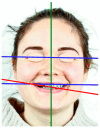Aesthetical and Functional Rehabilitation for an Ankylosed Maxillary Canine-A Case Report
- PMID: 39451874
- PMCID: PMC11506519
- DOI: 10.3390/clinpract14050159
Aesthetical and Functional Rehabilitation for an Ankylosed Maxillary Canine-A Case Report
Abstract
Background: As the functional and aesthetical importance of the canine cannot be overstated, the management of a missing canine is challenging. This case report describes the treatment of an infra-occluded ankylosed maxillary canine in a patient with previously failed orthodontic treatment. Case description: A 20-year-old patient sought a second opinion for orthodontic treatment failure. The patient presented with an impacted, ankylosed, and severely infra-occluded right maxillary canine, as well as an iatrogenic clockwise cant of the maxillary occlusal plane and several root resorptions. The treatment corrected the cant of the occlusal plane while avoiding further root resorption, partially extracted the upper right canine, improved the quality and quantity of the soft tissue in the newly edentulous area, and provided a prosthetic rehabilitation using a lithium disilicate ceramic resin-bonded cantilever bridge. Conclusions: The use of a cantilevered bridge resulted in an aesthetically pleasing and minimally invasive rehabilitation. This technique is reversible, does not affect pulp vitality, and is a viable solution for rehabilitating the smiles of young patients. Clinical significance: The smile rehabilitation for an ankylosed maxillary canine, especially in the case of a previously failed orthodontic treatment, is an important clinical challenge. A minimally invasive long-term restoration with a cantilever bridge is a viable solution. Functional and aesthetically pleasant results can be achieved with a multidisciplinary approach.
Keywords: ankylosed tooth; canine ankylosis; cantilever bridge; case report; decoronation; occlusal plane cant; root resorption.
Conflict of interest statement
The authors declare no conflicts of interest.
Figures











Similar articles
-
Biomechanically and Periodontally-Based Orthodontic Treatment of a Patient with Upper Canine Affected by External Cervical Resorption (ECR): A Case Report.Dent J (Basel). 2023 Nov 30;11(12):278. doi: 10.3390/dj11120278. Dent J (Basel). 2023. PMID: 38132416 Free PMC article.
-
[Preservation of alveolar bone of un-restorable traumatized maxillary incisors for future].Refuat Hapeh Vehashinayim (1993). 2004 Jan;21(1):54-9, 101-2. Refuat Hapeh Vehashinayim (1993). 2004. PMID: 15065385 Hebrew.
-
Conservatively replacing missing anterior teeth with resin bonded ceramic restorations.J Esthet Restor Dent. 2023 Jun;35(4):567-576. doi: 10.1111/jerd.12989. Epub 2022 Dec 13. J Esthet Restor Dent. 2023. PMID: 36511179
-
Decoronation for the management of an ankylosed young permanent tooth.Dent Traumatol. 2008 Feb;24(1):131-5. doi: 10.1111/j.1600-9657.2006.00506.x. Dent Traumatol. 2008. PMID: 18173685 Review.
-
Decoronation - a conservative method to treat ankylosed teeth for preservation of alveolar ridge prior to permanent prosthetic reconstruction: literature review and case presentation.Dent Traumatol. 2007 Apr;23(2):87-94. doi: 10.1111/j.1600-9657.2006.00454.x. Dent Traumatol. 2007. PMID: 17367456 Review.
Cited by
-
Management of an infectious complication appearing in a transcanine implant: a case report.Int J Implant Dent. 2025 May 19;11(1):37. doi: 10.1186/s40729-025-00626-6. Int J Implant Dent. 2025. PMID: 40388046 Free PMC article.
References
-
- Parrish J., Hills L., Ganesan K. Management of palatally ectopic canines part 2: Ankylosis hypotheses and southend experience. Adv. Mech. Mach. Sci. 2022;8:100349. doi: 10.1016/j.adoms.2022.100349. - DOI
Publication types
LinkOut - more resources
Full Text Sources
Research Materials

